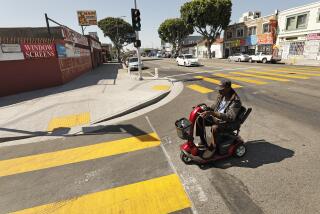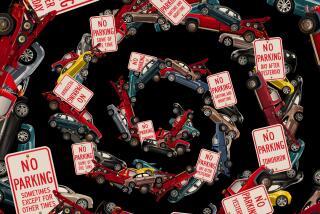Clunkers’ Last Stand
- Share via
Just north of the Santa Clarita city limits, up a dusty, rutted road, a man named Jack lives with a tiny pug, a lovely garden of prickly pear and the rusting hull of a pickup truck he says was driven by Clint Eastwood in the orangutan-buddy classic “Every Which Way But Loose.”
The old Chevy has sat out front of Jack’s place on and off since one of his sons bought it a decade ago. Sometimes it has run nicely, he says. Mostly it hasn’t run at all.
No one has complained that the pickup--from which Clyde the orangutan was frequently socking some ne’er-do-well motorcyclist in the 1978 movie--is an eyesore. Most of Jack’s neighbors have an old Ford van or Mercury Cougar soaking up the sun in the front yard as well.
Beginning Oct. 1, however, Jack Moore, his neighbors and probably tens of thousands of other residents in unincorporated areas of Los Angeles County risk punishment as lawbreakers. They could wake up one day to find a $55 ticket tucked under the rubberless windshield-wiper arm of their front-yard handicraft project.
That’s the day the county supervisors have decreed that authorities will begin to enforce an ordinance making it illegal to park vehicles on the front lawn, the latest attempt to throttle what proponents would call an ancient American liberty and what opponents excoriate as the classic American eyesore and neighborhood blight.
“The purpose of the ordinance is to enhance the appearance of the community and is the result of suggestions from the community,” says a letter from Sheriff Sherman Block to the County Board of Supervisors, which unanimously passed the ordinance in July.
“Well,” said Moore, a retired carpenter for the city of Los Angeles who moved out here from Redondo Beach 25 years ago for a little peace and quiet, “if I lived in the city I’d probably be of a like mind about it. But I’m also of the school that says if you’re not bothering your neighbors, let people be.”
There is certainly nothing new about such beautification ordinances. In Southern California, few things upset us more than threats to our property values. And old, unattractive cars on concrete blocks rank right up there with graffiti by the Chainsaw Crips.
Now new cars, shiny cars, cars that cost more than the president of the United States makes in a year--those kinds of cars we love. Aging cars, rusting cars, the kind teenagers in the far reaches of the county tinker with for years and then abandon without a pang when they move away--those kinds of cars we hate.
Many cities have similar ordinances in place. And since 1991, the county has had a zoning ordinance that prohibits parking cars in your front yard. But enforcing a zoning violation requires hearings, witnesses and considerable, costly paperwork.
Writing tickets, the thinking goes, will be much more efficient.
In a gesture of goodwill, county parking officers haven’t written a single one yet. Although the regulation went into effect in August, officers have issued more than 1,000 warnings but promised not to slap anyone with the fine until Oct. 1--and perhaps they’ll even extend the grace period beyond then.
“We’re trying to be fair and equitable on this ordinance because it is new,” said Cristina Economides, acting manager of the Sheriff’s Department’s parking enforcement detail. “We’re not going to go gung ho on it right away.”
Good thing, because there will likely be some technicalities to iron out. And a whole lot of tickets to write.
Back down the road from Jack’s home, a broken-down brown Pinto sits out front of a trailer, engine parts resting on its hood. But the Pinto is literally overshadowed by a much larger vehicle: an old fishing trawler propped up on blocks.
“The Pinto’s mine, but I’m moving to Kentucky,” a woman calls from inside the trailer. The boat, she says, belongs to her landlord.
And to heck with the boat; what about those neighbors who have six cars in their front yard, she asks.
As far as this ordinance goes, though, the boat is off the hook, said Sharon Bilbrey, assistant manager of the parking enforcement detail. “It only applies to autos.”
“What about go-carts?” asks another woman who lives just over the hill from the boat. “And I have my tractor . . . “
All issues for attorneys to sort out, certainly.
An even more vexing question might be determining the parameters of a “front yard, corner side yard or any additional area of a lot or parcel of land situated between the public right of way and any residence or accessory building or structure located therein . . . “ as the ordinance puts it.
In this case, the woman, who declined to give her name, wasn’t quite sure exactly which yard was the front yard and which was the back--and which were the sides, for that matter. And she’s lived here for years.
The go-cart may be in the front yard, she said, or it may be that the tractor is in the front. Or the two Camaros, abandoned by her now-grown son--naturally--could technically be in the front yard, though off to one side.
The legal complexities would reduce a Solomon to tears.
Nursing a nasty cold and standing in the 95-degree heat, the woman said she doesn’t have the money to fix the vehicles or have them towed away, let alone pay a fine and still have them sitting there.
“And what about horse trailers?” she asked with a sniffle. “You can’t do anything you want on your own land--especially in Southern California.”
More to Read
Sign up for Essential California
The most important California stories and recommendations in your inbox every morning.
You may occasionally receive promotional content from the Los Angeles Times.










